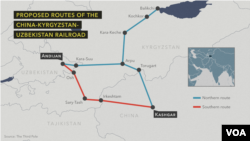Although weary of Beijing’s political ambitions and concerned about over-reliance on China, some Central Asians tell VOA they also see the benefits of the Belt and Road Initiative, or BRI, launched in 2013 as China’s global infrastructure endeavor.
Since its launch, China has funded at least 112 projects in Central Asia. Many of the projects were aimed at boosting transportation and connectivity such as the Qamchiq mountain highway.
“This mountain pass is where I make my living,” said Uzbek taxi driver Majid. The highway connects Tashkent, Uzbekistan’s capital, with the Ferghana Valley and reaches southern Kyrgyzstan and northern Tajikistan. Like others that VOA spoke with Majid was unwilling to give his full name, citing concerns that authorities might retaliate.
Majid drives an Uzbek-U.S. made Chevrolet Lacetti sedan that seats four passengers. He says he usually charges about $14 per person to drive to Kokand, which is about 130 kilometers (81 miles) southeast of Tashkent.
“I aim to make two roundtrips a day, which takes eight to nine hours in lighter traffic. It’s better than working for the government,” he told VOA. “Since this is my own car, I keep most of what I earn in my own pocket to take care of my large family.”
Driving commerce
In Osh, Kyrgyzstan’s second-largest city, on the other side of the Ferghana Valley, China’s economic influence is so widely felt it is common for residents to label any new infrastructure projects “Chinese.”
For Muzaffar, a frequent migrant worker, Beijing is the undisputed “superpower” in this part of the world.
“No other power has as much presence as China, which it pulls off without much publicity. Perhaps China wants us to get used to seeing its influence everywhere,” he wondered, adding that he wants his four children to learn Chinese alongside English and Russian.
In Tajikistan’s second-largest city of Khujand, known for its Panjshanbe bazaar, traders told VOA that they buy and sell mostly Chinese goods.
“They are our lifeline. No commerce is conducted without Chinese merchandise,” which is the easiest to obtain and sell and is the most affordable, according to Mohira, who commutes to Khujand from Ferghana, Uzbekistan, via the Andarkhon-Patar border crossing. “Our Chinese cargo always arrives within a day or two. Very reliable service.”
Yet merchants such as Mohira are unsure about the impact on the local economy of a planned railway project that will connect China with Kyrgyzstan and Uzbekistan. Officials said a feasibility study will soon be completed.
China-Kyrgyzstan-Uzbekistan railroad
The proposed 523-kilometer (325-mile) line will carry passengers and freight between Kashgar in China’s Xinjiang region and Andijan in Uzbekistan by way of Karasu, Kyrgyzstan.
Four months ago, Chinese media reported that construction would start sometime this year, citing a statement by Umidulla Ibragimov, an Uzbekistan Railways official.
Yicai Global, a Chinese state-backed English financial news site, said the railway will give countries in Central Asia the shortest and most accessible passage to global markets, describing it as a bridge between Europe and Asia.
Beijing believes that the new connection will “accelerate the West China Development Project” and “promote the development and use of oil in the Central Asia and Caspian Sea areas, open up new sources of oil imports to China, and change the country's energy development strategy”—something highlighted at the Shanghai Cooperation Organization’s summit in Samarkand last year, according to China’s state news agency, Xinhua.
Frank Maracchione, a Ph.D. candidate at England’s University of Sheffield who is researching China’s Belt and Road Initiative in Central Asia, said many experts he has interviewed in Uzbekistan saw Beijing’s efforts as an attempt to rebuild the Great Silk Road.
Minerals, trade and beyond
Extraction, processing and transportation of natural resources, including minerals, represent a large chunk of Chinese investment in Uzbekistan, which amounted to $3.8 billion in 2022, just behind Russia’s $4.8 billion.
“A second large area of investment is transport infrastructure mostly for trade purposes to improve regional connectivity,” said Maracchione. He added that China is also focusing on agriculture and technology. That will lead to investments in education and expertise, a boost to long-term development welcomed by Central Asians, said Maracchione.
China no longer regards Central Asia as just the source of raw materials. It is quickly becoming a manufacturing base, Maracchione said. Examples in Uzbekistan, where mainly locals are employed, include the Pengsheng industrial park, the SCO Center for Agriculture in Sirdarya, the Nukus Herbal Technology pharmaceutical producer, the import-export Lanextract Sino-Uzbek joint venture in Karakalpakstan, and the Uzbek-Chinese electric vehicle production cluster in Jizzakh.
Angst growing
In recent years, there has been growing public anger toward Chinese businesses and influence in Kazakhstan and Kyrgyzstan. But Uzbekistan, Tajikistan and Turkmenistan, similarly known for their poor human rights records and tight control of expression and the media, have not seen such clear expressions of anti-Chinese sentiment.
“Why curse those who invest in us? I wish more Chinese companies would come in, so that we could sell off all the stale state assets we’ve been struggling to privatize,” said one retired government official, requesting to be identified only as Qodir.
In an expanding area emerging as New Tashkent, he pointed to a gigantic sports development, the Olympic village. Its construction site bears the logos of Sinomach and CAMCE—the China National Machinery Industry Corporation — and its subsidiary, CAMC Engineering.
Financed by Beijing’s Export-Import Bank, the $289 million project is among several recent deals, including a $440 million chemical plant in Navoi, in central Uzbekistan.
Rights activists have decried poor working conditions at Chinese-owned enterprises in the Uzbek cities of Bukhara and Margilan.
“The pay was low, the working hours were long and there were chemicals everywhere,” Maracchione’s field research found.
In September, Sinomash reached an agreement with the local government in the eastern Uzbek city of Ferghana to produce drinking water from the Kampirobod dam on the Uzbek-Kyrgyz border. The Uzbek side announced that it had signed 32 trade and investment deals with Beijing worth $1.37 billion.
Marrachione said a “controversial aspect of China’s investment in Central Asia is the potential development of patterns of dependency on Chinese investment and unsustainable lending practices leading to excessive debt and a volatile financial situation.”
"This is true particularly in Tajikistan and Kyrgyzstan,” he said. “Starting from the latter, loans from the Export-Import Bank of China accounted for a bit less than half of Kyrgyzstan’s external debt and exactly 42.89% in May 2021, and around 40% of Tajikistan’s external debt.”
China is now the largest bilateral creditor in Uzbekistan, even though last year what Tashkent owes to China accounted for only 17.6% of the external debt.
Talking to VOA at a business forum in Washington, Uzbekistan’s Digital Technology Minister Sherzod Shermatov described China as a convenient investor and partner.
“I’m eager to work with any side that Uzbekistan benefits from. What matters most for us is what we stand to gain, not what America, Russia or China get. We focus on our own interests, Uzbekistan’s interests,” said Shermatov.











